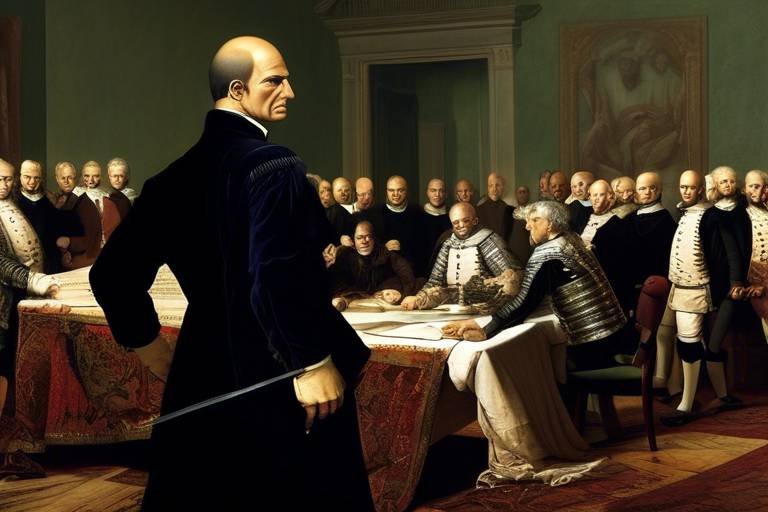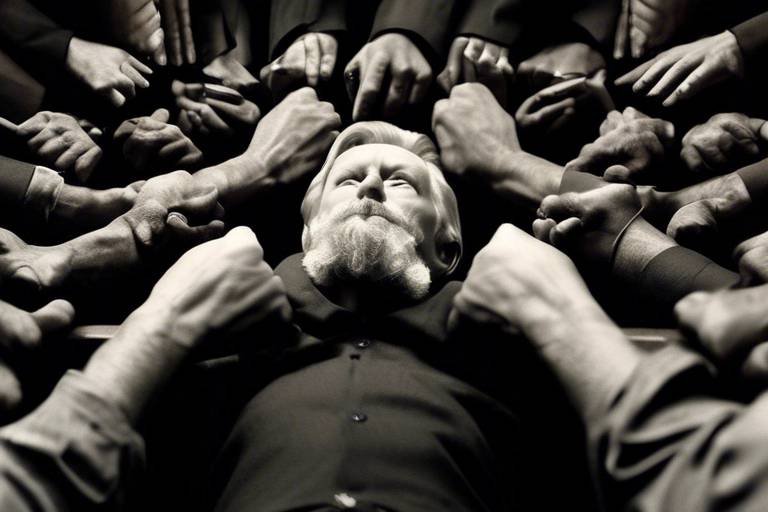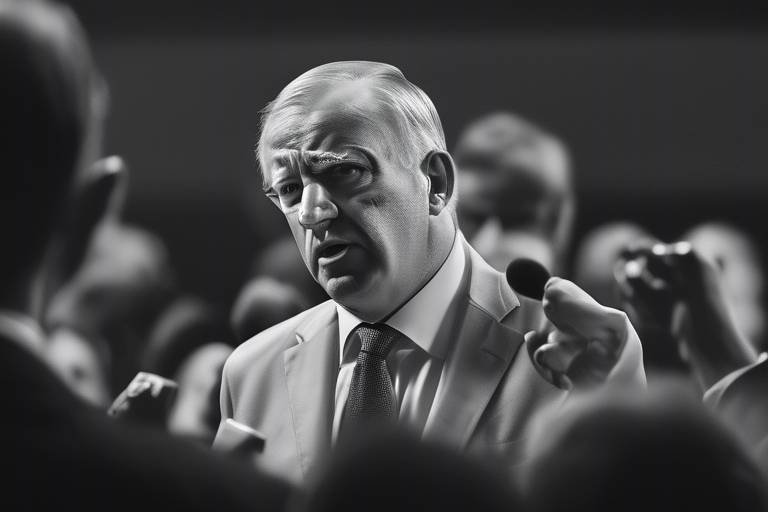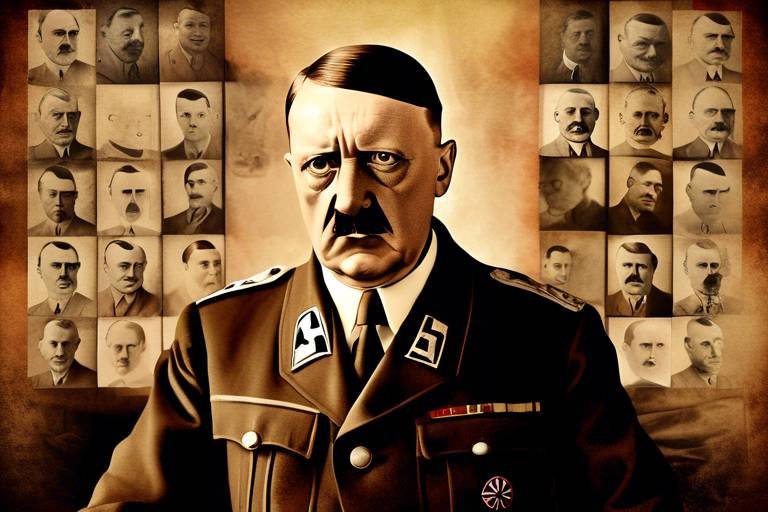Right Wing vs. Left Wing - A Philosophical Analysis
The ideological spectrum of politics is often visualized as a continuum, where the terms right-wing and left-wing serve as anchors that help us navigate the complex landscape of beliefs and values. But what does it really mean to be right or left? This article aims to unravel the intricate tapestry of political ideologies, exploring their historical roots, core beliefs, and the implications they hold for governance and individual freedoms. As we delve into this philosophical analysis, you may find yourself pondering: How did these ideologies come to shape our societies? And what does this mean for our future?
To truly understand the evolution of right-wing and left-wing ideologies, we must journey back in time. The terms originated during the French Revolution in the late 18th century, where supporters of the king sat on the right side of the assembly, while those advocating for revolutionary change occupied the left. This historical backdrop laid the foundation for the ideological divide we witness today. Over the centuries, these labels have morphed, influenced by events such as the Industrial Revolution, the rise of socialism, and the emergence of modern democracies. Each era has contributed layers of meaning to what it means to be right or left, shaping political discourse and societal values.
At the heart of right-wing and left-wing ideologies lie fundamental principles that dictate their approach to governance, economy, and social issues. Right-wing beliefs often emphasize individualism, advocating for personal responsibility and minimal government interference. In contrast, left-wing ideologies prioritize collectivism, promoting the idea that society should work together to address inequalities. These core beliefs manifest in various ways, particularly in economic policies and social values, which we will explore in greater detail below.
Economic strategies serve as one of the most significant differentiators between right-wing and left-wing ideologies. Right-wing proponents typically champion free markets and minimal taxation, believing that a self-regulating market leads to greater prosperity for all. They argue that individuals should have the freedom to pursue their economic interests without excessive government interference. On the other hand, left-wing advocates call for regulation and social welfare programs aimed at redistributing wealth and addressing inequalities. They view government intervention as a necessary tool to ensure that everyone has access to basic needs and opportunities.
Right-wing economic perspectives often revolve around the belief that individual entrepreneurship is the engine of economic growth. By minimizing taxes and regulations, they argue, governments can create an environment where businesses thrive, leading to job creation and increased wealth. This ideology rests on the assumption that the market will naturally correct itself, allowing competition to drive innovation and efficiency. However, critics may argue that this approach can lead to significant disparities in wealth and opportunity, leaving vulnerable populations without support.
In stark contrast, left-wing economic ideologies emphasize the importance of wealth redistribution and social safety nets. They argue that government involvement is essential for leveling the playing field, particularly for marginalized groups. By implementing progressive taxation and funding social programs, left-wing advocates seek to mitigate the effects of capitalism that can lead to inequality. They believe that a fair society is one where everyone has access to education, healthcare, and a living wage, ultimately fostering a more equitable economy.
Beyond economics, social values play a crucial role in defining right-wing and left-wing ideologies. Right-wing beliefs often align with traditional values, emphasizing the importance of family, religion, and national identity. They may resist rapid social changes, advocating for policies that uphold these values. Conversely, left-wing ideologies tend to champion progressive social values, advocating for issues such as civil rights, gender equality, and LGBTQ+ rights. This divergence in social values not only influences legislation but also shapes the cultural landscape of societies.
The extent to which each wing supports or opposes government intervention reveals stark contrasts in their approaches to governance. Right-wing ideologies typically advocate for limited government intervention, arguing that individuals should be responsible for their own lives and that markets should dictate social outcomes. They believe that too much government control can stifle innovation and personal freedom. In contrast, left-wing ideologies argue for substantial government intervention, viewing it as essential for addressing systemic issues and promoting social justice. They contend that without active government involvement, inequalities will persist, hindering progress for the most vulnerable members of society.
Right-wing ideologies often promote the idea that a free society thrives when individuals are empowered to make their own choices. They emphasize the importance of personal responsibility and self-reliance, believing that government should play a minimal role in the lives of citizens. This belief extends to various aspects of life, including education, healthcare, and welfare, where right-wing advocates argue that market solutions are often more efficient than government programs.
In contrast, left-wing ideologies argue that government intervention is not just beneficial but necessary for achieving equitable progress. They contend that systemic inequalities require systemic solutions, and that government has a moral obligation to protect its citizens and ensure that everyone has access to the resources they need to thrive. This perspective often leads to calls for comprehensive reforms in healthcare, education, and social services, aiming to create a more just and inclusive society.
- What is the main difference between right-wing and left-wing politics?
The primary difference lies in their approach to economic policies, social values, and government intervention. - Can someone identify with both right-wing and left-wing ideologies?
Yes, many individuals may hold beliefs from both sides of the spectrum, leading to a more nuanced political identity. - How do these ideologies affect individual freedoms?
Right-wing ideologies often prioritize personal freedoms, while left-wing ideologies focus on collective rights and social justice.

Historical Context
Understanding the origins of right-wing and left-wing ideologies helps clarify their evolution and impact on political discourse throughout history, from the French Revolution to contemporary politics. The terms "right" and "left" originated during the French Revolution in the late 18th century, where members of the National Assembly divided themselves into factions based on their political beliefs. Those who sat on the left generally supported revolutionary ideas and social equality, while those on the right favored tradition, hierarchy, and the maintenance of the monarchy.
As the years rolled on, these ideological divisions morphed and adapted to the changing political landscapes of various nations. For instance, the Industrial Revolution brought about significant economic shifts, leading to the rise of labor movements that leaned left, advocating for workers' rights and social reforms. Conversely, the right wing often responded with a focus on capitalism and free enterprise, aiming to protect business interests and maintain social order. This tug-of-war between progressivism and conservatism has shaped not only national policies but also global relationships.
Throughout the 20th century, the ideological spectrum expanded further, particularly during the Cold War era. This period was marked by a fierce ideological battle between capitalist Western nations and communist Eastern Bloc countries. The right-wing ideologies were often associated with capitalism, democracy, and individualism, while left-wing ideologies were linked to socialism, collectivism, and state control. The outcomes of these ideological conflicts have had lasting effects on international relations, influencing everything from foreign policy to economic alliances.
Today, the conversation has evolved yet again, with the rise of populist movements and new political parties that challenge traditional definitions of left and right. Issues such as climate change, immigration, and social justice have forced both wings to reevaluate their positions and adapt to the needs of a globalized world. The historical context of these ideologies not only provides insight into their current forms but also highlights the ongoing debates and discussions that continue to shape our societies.
| Year | Event | Impact on Ideologies |
|---|---|---|
| 1789 | French Revolution | Birth of left and right political spectrum |
| 1848 | Revolutions of 1848 | Rise of socialist movements in Europe |
| 1917 | Russian Revolution | Establishment of communist ideology |
| 1989 | Fall of the Berlin Wall | End of Cold War, shift towards neoliberal policies |
In summary, the historical context of right-wing and left-wing ideologies reveals a rich tapestry of conflict, adaptation, and evolution. Understanding this background not only sheds light on current political dynamics but also helps us anticipate future trends and challenges. As we continue to navigate the complexities of modern governance, recognizing the philosophical roots of these ideologies can provide us with valuable insights into the ongoing discourse surrounding freedom, equality, and justice.

Core Beliefs
The ideological divide between the right wing and left wing is not just a matter of political preference; it's a reflection of deeply rooted that shape how individuals view the world. These beliefs influence everything from economic policies to social values, and they play a crucial role in determining how societies are governed. At the heart of these ideologies lies a fundamental question: what is the role of government in our lives? This question leads us to explore the distinct philosophies that define each wing.
Right-wing ideologies often champion the principles of individualism and self-reliance. They argue that personal freedom is paramount and that individuals should have the liberty to pursue their own paths without excessive government interference. This belief in personal responsibility is closely tied to economic policies that favor free markets. Right-wing proponents argue that when individuals are left to their own devices, innovation flourishes, and the economy thrives. They see government regulation as a hindrance that stifles growth and creativity.
On the other hand, left-wing ideologies are grounded in the belief that society has a collective responsibility to ensure that all individuals have access to basic needs and opportunities. This perspective emphasizes the importance of community and social justice. Left-wing supporters argue that without government intervention, systemic inequalities will persist, leaving the most vulnerable members of society without support. They advocate for policies that promote wealth redistribution and social welfare programs aimed at leveling the playing field.
When it comes to economic policies, the differences between the two wings become even more pronounced. For instance, right-wing economic views typically prioritize free enterprise, minimal taxation, and limited government involvement. They believe that a laissez-faire approach allows the market to regulate itself, ultimately leading to greater prosperity for all. In contrast, left-wing economic views advocate for a more active role of government in the economy, emphasizing the need for regulations that protect workers, consumers, and the environment. This often translates into support for higher taxes on the wealthy to fund social programs that benefit the broader population.
In terms of social values, right-wing ideologies tend to uphold traditional norms and values, often advocating for policies that reflect a more conservative approach to issues such as education, healthcare, and civil rights. They may argue that societal stability is best achieved by adhering to established customs and practices. Conversely, left-wing ideologies typically push for progressive reforms that challenge the status quo. They advocate for policies that promote inclusivity, diversity, and equal rights for all, believing that a more equitable society is not only just but also beneficial for long-term societal health.
In summary, the core beliefs of right-wing and left-wing ideologies are deeply intertwined with their views on the role of government, economic policies, and social values. While right-wing perspectives celebrate individualism and market freedom, left-wing beliefs emphasize collective responsibility and social justice. Understanding these fundamental differences is crucial for anyone looking to engage meaningfully in political discourse.
- What are the main differences between right-wing and left-wing ideologies?
Right-wing ideologies prioritize individualism and free markets, while left-wing ideologies emphasize collective responsibility and social justice. - How do economic policies differ between the two wings?
Right-wing economic policies favor minimal government intervention and low taxes, whereas left-wing policies advocate for regulation and wealth redistribution. - What role does government play in each ideology?
Right-wing ideologies support limited government intervention, while left-wing ideologies argue for substantial government involvement to address social issues.

Economic Policies
The ideological divide between right-wing and left-wing politics is particularly evident in their economic policies, which serve as the backbone of their respective beliefs. These policies not only shape the economic landscape but also reflect the values and priorities of each ideology. Right-wing economics often champions the idea of a free market, where individual initiative and entrepreneurship are seen as the driving forces of economic growth. Proponents argue that when businesses operate with minimal government interference, they can innovate and create jobs, leading to a thriving economy. This belief in the power of the market is akin to planting a seed in fertile soil; given the right conditions, it can flourish into something remarkable.
On the flip side, left-wing economic policies advocate for a more regulated economy that prioritizes social welfare and equity. This approach is rooted in the belief that without government intervention, the rich will get richer while the poor are left behind, creating a widening gap in wealth and opportunity. Here, the government is viewed as a gardener, essential for nurturing the economy and ensuring that all individuals have access to the resources they need to thrive. This perspective leads to calls for robust social safety nets, progressive taxation, and policies aimed at redistributing wealth to create a more balanced society.
To better illustrate these contrasting views, let’s break down some key economic policies associated with each ideology:
| Aspect | Right-Wing Economic Policies | Left-Wing Economic Policies |
|---|---|---|
| Market Regulation | Minimal regulation to encourage free enterprise | Strong regulation to protect consumers and workers |
| Taxation | Lower taxes to stimulate investment | Higher taxes on the wealthy to fund social programs |
| Government Role | Limited government involvement in the economy | Active government intervention to address inequalities |
| Social Welfare | Minimal social safety nets | Comprehensive social welfare programs |
As we can see, the right-wing approach is often characterized by a belief in individualism and the idea that personal responsibility leads to success. They argue that the market, when left alone, naturally corrects itself and allocates resources efficiently. This belief can sometimes lead to a disregard for the broader social implications of economic policies, as the focus remains on the individual rather than the collective.
Conversely, left-wing economic policies emphasize community and the idea that everyone deserves a fair shot at success. By advocating for government intervention, they aim to level the playing field, ensuring that disadvantaged groups receive the support they need to compete. This philosophy is often met with skepticism from right-wing advocates, who argue that too much government involvement stifles innovation and personal initiative.
In summary, the economic policies of right-wing and left-wing ideologies reflect fundamentally different beliefs about the role of government, the importance of individual versus collective responsibility, and the best ways to achieve economic prosperity. Understanding these differences is crucial for engaging in informed discussions about policy and governance, as each side offers valuable insights into the complex nature of our economic systems.

Right-Wing Economic Views
When we dive into the world of right-wing economic views, we uncover a philosophy that champions individual entrepreneurship and a market-driven approach to wealth creation. Right-wing proponents often argue that a free market is the best mechanism for fostering innovation and economic growth. They believe that when individuals are given the freedom to pursue their own interests, the entire economy benefits. This belief is rooted in the idea that competition drives efficiency and leads to better products and services for everyone. Think of it like a garden: when each plant has enough space and resources to grow, the garden flourishes as a whole.
One of the cornerstone principles of right-wing economics is the advocacy for minimal taxation. The argument here is straightforward: lower taxes mean more money in the hands of individuals and businesses, allowing them to invest, spend, and create jobs. This perspective holds that when the government takes less from its citizens, it empowers them to make their own financial decisions, ultimately leading to a more vibrant economy. However, critics often counter this view by pointing out that reduced taxation can lead to decreased funding for essential public services, which can create disparities in society.
Another key aspect of right-wing economic ideology is the belief in limited government interference. Right-wing advocates argue that the government should play a minimal role in the economy, as excessive regulation can stifle innovation and create inefficiencies. They often promote the idea of self-regulation, suggesting that industries are best equipped to manage themselves without government oversight. For them, the market is like an invisible hand that guides economic activity, ensuring that resources are allocated efficiently and effectively.
To illustrate these points further, let’s consider a few examples of right-wing economic policies:
- Tax Cuts: Implementing tax reductions for individuals and corporations to stimulate investment and spending.
- Deregulation: Reducing government regulations on businesses to encourage growth and competition.
- Privatization: Shifting public services and assets to private ownership to enhance efficiency and reduce government spending.
In summary, right-wing economic views are characterized by a strong belief in the power of the individual and the market. Advocates argue that by minimizing government intervention and maximizing personal freedoms, we can create a thriving economy that benefits everyone. However, this perspective is not without its challenges, as the balance between free-market principles and the need for social safety nets remains a contentious debate.
- What are the main principles of right-wing economics?
Right-wing economics primarily focuses on individual entrepreneurship, minimal taxation, and limited government interference. The belief is that these elements foster a more efficient and innovative economy. - How do right-wing economic policies impact social services?
Critics argue that reduced taxation and limited government intervention can lead to underfunded public services, which may disproportionately affect vulnerable populations. Supporters, however, believe that a thriving private sector can provide alternative solutions. - What is the role of competition in right-wing economic views?
Competition is seen as a driving force for efficiency and innovation. Right-wing advocates argue that when businesses compete freely, they are incentivized to improve their offerings, benefiting consumers in the process.

Left-Wing Economic Views
Left-wing economic views are rooted in the belief that the government plays a crucial role in ensuring social equity and justice. Unlike their right-wing counterparts, who often champion the idea of a self-regulating market, left-wing ideologies advocate for government intervention as a means to address systemic inequalities. This perspective is grounded in the belief that unregulated markets can lead to significant disparities in wealth and opportunity, leaving vulnerable populations at a disadvantage.
At the heart of left-wing economic thought is the concept of wealth redistribution. This idea posits that resources should be distributed more equitably across society to ensure that everyone has access to basic needs such as healthcare, education, and housing. For instance, progressive taxation is often proposed as a solution, where those with higher incomes contribute a larger percentage of their earnings to fund social programs that benefit the less fortunate. This approach not only aims to alleviate poverty but also to promote a sense of community and shared responsibility.
Moreover, left-wing economic policies often emphasize the importance of social safety nets. These are programs designed to provide support during times of economic hardship, such as unemployment benefits, food assistance, and healthcare coverage. The rationale behind these safety nets is simple: they help individuals and families maintain a basic standard of living, thereby fostering a more stable and productive society. By investing in the well-being of its citizens, a left-wing government seeks to create a more resilient economy that can withstand shocks and challenges.
In addition to wealth redistribution and social safety nets, left-wing economic views also advocate for government involvement in the economy. This can take many forms, such as regulating industries to protect consumers and the environment, or investing in public services like transportation and education. The idea is that by taking an active role in the economy, the government can help to correct market failures and promote sustainable growth. For example, initiatives aimed at transitioning to renewable energy sources not only address climate change but also create jobs and stimulate economic growth.
Ultimately, left-wing economic views are about striving for a society where everyone has the opportunity to thrive, regardless of their background. By addressing inequalities and promoting fairness, left-wing ideologies seek to create a more inclusive economy that benefits all members of society. As we navigate the complexities of modern governance, understanding these perspectives is essential to fostering productive discussions about the future of our economies and the well-being of our communities.
- What are the main differences between left-wing and right-wing economic views?
Left-wing views emphasize government intervention and wealth redistribution, while right-wing views prioritize free markets and minimal government interference. - How do left-wing economic policies affect businesses?
Left-wing policies may impose regulations and higher taxes on businesses, but they also aim to create a more equitable market environment that can benefit consumers. - What role does taxation play in left-wing economic views?
Taxation is seen as a tool for wealth redistribution, where higher earners contribute more to fund social programs that support the less fortunate. - Can left-wing economic policies lead to economic growth?
Yes, by investing in social programs and infrastructure, left-wing policies can stimulate economic growth while promoting social equity.

Social Values
When we dive into the world of social values, it's like peeling back the layers of an onion—each layer revealing deeper insights into how different ideologies perceive morality and ethics. Right-wing and left-wing beliefs shape our social fabric, influencing everything from education to healthcare, and even civil rights. At the heart of these values lies a fundamental question: What do we prioritize as a society? Is it individual freedom and responsibility, or is it collective well-being and equality?
Right-wing ideologies often champion traditional values, emphasizing the importance of family, religion, and community. They tend to advocate for a societal structure that rewards hard work and personal achievement. This perspective sees social issues as individual challenges that people must overcome on their own, promoting the idea that success is a direct result of one's effort. For instance, in education, right-wing proponents might argue for school choice and charter schools, believing that competition fosters improvement and innovation.
On the flip side, left-wing ideologies place a strong emphasis on inclusivity and social justice. They argue that systemic inequalities—be it based on race, gender, or economic status—must be addressed through collective action and government intervention. Leftists advocate for policies that ensure access to education and healthcare for all, viewing these as fundamental rights rather than privileges. They believe that a society should work towards leveling the playing field, enabling everyone to have a fair shot at success.
To illustrate these contrasting views, consider the following table that highlights key differences in social values:
| Aspect | Right-Wing Values | Left-Wing Values |
|---|---|---|
| Family Structure | Traditional, nuclear family | Diverse family structures, including single-parent and LGBTQ+ families |
| Education | School choice, competition | Public education, equity in access |
| Healthcare | Private healthcare, individual responsibility | Universal healthcare, government involvement |
| Civil Rights | Emphasis on individual rights | Focus on group rights and social justice |
These contrasting beliefs create a vibrant tapestry of social values that shape our communities. While right-wing perspectives often advocate for a meritocratic approach, left-wing views emphasize the need for systemic change to ensure that everyone has the opportunity to thrive. This dichotomy raises important questions about the role of government, the importance of community, and the essence of what it means to be a just society.
Ultimately, the debate between right-wing and left-wing social values is not just about politics; it's about how we envision our future. Do we see ourselves as individuals navigating life’s challenges on our own, or do we believe in a collective responsibility to uplift one another? The answers to these questions will continue to shape the political landscape and influence the policies that govern our lives.
- What are the main differences between right-wing and left-wing ideologies?
Right-wing ideologies typically emphasize individualism, free markets, and limited government intervention, while left-wing ideologies focus on social equality, government involvement in the economy, and collective responsibility. - How do social values influence political decisions?
Social values shape the priorities of political parties and influence legislation, affecting areas such as education, healthcare, and civil rights. - Can individuals hold beliefs from both sides of the spectrum?
Yes, many people identify as moderates or hold beliefs that incorporate elements from both right-wing and left-wing ideologies.

Government Intervention
When it comes to the role of government in society, right-wing and left-wing ideologies present a fascinating dichotomy. The right-wing stance generally promotes the idea of limited government intervention. Proponents argue that the market is a self-regulating entity, capable of addressing societal needs without the heavy hand of government involvement. They believe that individuals should take personal responsibility for their actions and that the free market should dictate social outcomes. In this view, government interference is often seen as a hindrance to economic growth and personal freedom.
On the flip side, left-wing ideologies argue for a more active role of government in addressing systemic issues. They contend that without intervention, inequalities will persist and widen. For leftists, government action is essential for social justice and equitable progress. They advocate for policies that promote wealth redistribution, social safety nets, and robust public services, viewing these measures as necessary to protect vulnerable populations and ensure that everyone has access to basic needs like healthcare and education.
To illustrate the differences in government intervention between the two wings, consider the following table:
| Aspect | Right-Wing Perspective | Left-Wing Perspective |
|---|---|---|
| Government Role | Minimal | Active |
| Market Regulation | Self-regulating | Necessary for fairness |
| Social Welfare | Limited support | Comprehensive support |
| Individual Responsibility | Highly emphasized | Shared responsibility |
These contrasting views on government intervention not only shape economic policies but also influence broader societal issues. For instance, in the realm of healthcare, right-wing advocates may argue for privatization and competition to drive efficiency, while left-wing proponents push for universal healthcare as a fundamental right, believing that it is the government's duty to ensure health access for all citizens.
Furthermore, the debate extends into education, where right-wing ideologies might favor school choice and voucher systems, promoting competition among schools. In contrast, left-wing ideologies typically support public education funding and equitable access to quality education, viewing it as a means to level the playing field.
Ultimately, the question of government intervention is a pivotal point of contention in political discourse. As society continues to evolve, the implications of these ideologies on governance and public policy will remain significant. The challenge lies in finding a balance that addresses the needs of the populace while respecting individual freedoms and market dynamics.
- What is the main difference between right-wing and left-wing ideologies? Right-wing ideologies typically emphasize individualism, free markets, and limited government, while left-wing ideologies focus on equality, social justice, and government intervention to achieve these goals.
- How do economic policies differ between the two wings? Right-wing economic policies favor deregulation and minimal taxation, whereas left-wing policies advocate for wealth redistribution and social welfare programs.
- Why is government intervention a contentious issue? The debate revolves around the extent to which government should be involved in the economy and social issues, with each side believing their approach is essential for societal well-being.

Right-Wing Stance
When we dive into the , we encounter a fascinating tapestry of beliefs and principles that shape its ideology. At the heart of right-wing politics is a steadfast commitment to individualism and the idea that personal responsibility is paramount. This perspective champions the notion that individuals should have the freedom to pursue their own paths, often equating success with hard work and determination. Right-wing advocates argue that when people are left to their own devices, they can innovate and create, ultimately leading to a more prosperous society.
Another cornerstone of right-wing ideology is the belief in limited government intervention. Proponents argue that government should play a minimal role in the economy and in people's lives. They often view excessive regulation as a hindrance to entrepreneurship and economic growth. This belief is rooted in the idea that markets are inherently efficient and that they should be allowed to operate without government interference. For instance, consider the classic metaphor: a garden left to grow wild will often produce a more vibrant ecosystem than one that is overly pruned and controlled. In this way, right-wing thinkers advocate for a laissez-faire approach, trusting that the invisible hand of the market will lead to better outcomes for all.
In terms of economic policies, right-wing ideologies typically favor free-market capitalism. This means promoting policies that reduce taxes, deregulate industries, and encourage private enterprise. The argument here is that lower taxes provide individuals and businesses with more resources to invest and spend, which in turn stimulates economic growth. However, critics often counter that this approach can exacerbate social inequalities, as not everyone starts from the same economic baseline. Yet, right-wing supporters maintain that the benefits of a thriving economy will eventually trickle down to all layers of society.
Moreover, the right-wing stance often emphasizes the importance of traditional values. This can manifest in various ways, from advocating for family structures to promoting religious freedoms. Right-wing ideologues often argue that a stable society is built on strong family units and moral frameworks, which they believe are essential for maintaining social order. They may view changes in social norms, such as shifts in marriage definitions or family dynamics, with skepticism, arguing that these changes can lead to societal fragmentation.
In summary, the right-wing stance is characterized by a belief in individual freedom, limited government, and traditional values. While it champions the idea of self-regulation and market efficiency, it also grapples with the implications of these beliefs on social equity. The ongoing debate between right-wing and left-wing ideologies reflects a broader struggle over the role of government, the nature of individual rights, and the path toward a just society.
- What is the main difference between right-wing and left-wing ideologies?
Right-wing ideologies typically emphasize individualism, free markets, and limited government, while left-wing ideologies focus on social equality, government intervention, and wealth redistribution. - Why do right-wing supporters advocate for less government?
They believe that a free market without excessive regulation fosters innovation and economic growth, leading to better outcomes for society as a whole. - How do right-wing economic policies affect social inequality?
Critics argue that while these policies can stimulate economic growth, they may also widen the gap between the wealthy and the poor, as not all individuals have equal opportunities to succeed.

Left-Wing Stance
The is characterized by a robust belief in the necessity of government intervention to address social inequalities and promote justice. This ideology posits that without active government involvement, the disparities between different social classes can widen, leading to a society where the rich get richer, and the poor remain trapped in cycles of poverty. To many left-wing proponents, the government is not just a regulatory body; it is a crucial instrument for fostering equality and ensuring that all individuals have access to basic needs, such as healthcare, education, and housing.
One of the cornerstones of left-wing ideology is the concept of social justice. This principle asserts that everyone deserves equal rights and opportunities, regardless of their background. Advocates argue that systemic issues, such as racism, sexism, and economic inequality, require proactive measures to dismantle. By implementing policies that promote inclusivity and protect marginalized groups, left-wing ideologies aim to create a more equitable society. For instance, affirmative action programs and anti-discrimination laws are often championed as necessary tools to level the playing field.
Moreover, left-wing ideologies typically support a comprehensive social safety net. This includes programs like universal healthcare, affordable housing initiatives, and unemployment benefits, which are designed to support individuals during challenging times. The belief here is simple yet profound: when people have their basic needs met, they are more likely to contribute positively to society. This approach not only enhances individual well-being but also promotes a more productive and engaged citizenry, which ultimately benefits the economy as a whole.
Additionally, the left-wing stance emphasizes the importance of environmental sustainability. Many left-leaning political movements advocate for strong regulations to combat climate change and protect natural resources. They argue that a healthy planet is essential for future generations and that government intervention is necessary to curb corporate practices that harm the environment. This perspective often leads to policies promoting renewable energy, conservation efforts, and stricter pollution controls, all aimed at creating a sustainable future.
In summary, the left-wing stance is rooted in the belief that government intervention is essential for creating a just and equitable society. By prioritizing social justice, supporting a robust social safety net, and advocating for environmental sustainability, left-wing ideologies seek to address systemic issues and promote a fairer world for all. The dialogue surrounding these beliefs is vital, as it shapes the landscape of modern politics and influences the direction of public policy.
- What are the main goals of left-wing politics? Left-wing politics primarily aim to achieve social justice, economic equality, and environmental sustainability through government intervention and regulation.
- How does left-wing ideology view government intervention? Left-wing ideology supports significant government intervention as a means to address systemic inequalities and provide essential services to all citizens.
- What role does social justice play in left-wing politics? Social justice is a central tenet of left-wing politics, advocating for equal rights and opportunities for all individuals, particularly marginalized groups.
- Are left-wing economic policies effective? Proponents argue that left-wing economic policies, such as wealth redistribution and social welfare programs, are effective in reducing inequality and promoting social welfare.
Frequently Asked Questions
- What is the main difference between right-wing and left-wing ideologies?
The primary difference lies in their approach to governance and social issues. Right-wing ideologies often prioritize individualism, free markets, and limited government intervention, while left-wing ideologies emphasize equality, social welfare, and greater government involvement in economic matters.
- How did the terms "right-wing" and "left-wing" originate?
These terms originated during the French Revolution, where supporters of the king sat on the right side of the assembly, and those advocating for reform and change sat on the left. This seating arrangement symbolized the broader ideological divide that has persisted through history.
- What are the economic policies typically associated with right-wing politics?
Right-wing economic policies generally favor free-market principles, minimal taxation, and reduced government regulation. The belief is that a self-regulating market promotes efficiency and innovation, allowing individuals to thrive based on their own efforts.
- What are the economic views held by left-wing ideologies?
Left-wing economic views focus on wealth redistribution, social safety nets, and government intervention to address inequalities. They argue that such measures are necessary to protect vulnerable populations and ensure a fairer distribution of resources.
- How do right-wing and left-wing ideologies differ in their views on social values?
Right-wing ideologies often uphold traditional values and emphasize personal responsibility, while left-wing ideologies advocate for progressive social policies that promote inclusivity and civil rights. These differences influence various issues, including education, healthcare, and individual freedoms.
- What is the stance of right-wing ideologies on government intervention?
Right-wing ideologies typically advocate for minimal government intervention, believing that individuals should take personal responsibility for their actions and that the market should dictate social outcomes without excessive regulation.
- What do left-wing ideologies believe about government intervention?
Left-wing ideologies argue for substantial government intervention, viewing it as essential for addressing systemic issues and promoting social justice. They believe that government action is necessary to create equitable opportunities for all citizens.



















